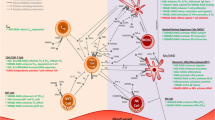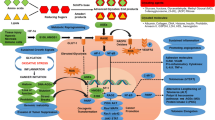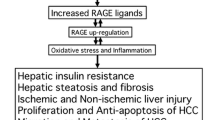Abstract
The interaction of glucose-modified and inflammation-promoting ligands with the receptor for advanced glycation end products (RAGE) is emerging as a central mechanism contributing to the diverse complications of diabetes. These ligands, particularly in oligomeric form, bind to RAGE and transduce intracellular signals. The consequences of this interaction, as elucidated in cultured cells and animal models, include upregulation of inflammatory and tissue-degradative pathways. Pharmacologic antagonism of RAGE may hold promise for the treatment of diabetic complications.
Similar content being viewed by others
References and Recommended Reading
Brownlee M: Advanced glycation end products in diabetic complications. Curr Opin Endocrinol Diabetes 1996, 3:291–297.
Anderson MM, Requena JR, Thorpe SR, Heinecke J: The myeloperoxidase system of human phagocytes generates N-epsilon (carboxymethyl)lysine on proteins: a mechanism for producing advanced glycation end products at sites of inflammation. J Clin Invest 1999, 104:103–113.
Girones X, Guuimera A, Cruz-Sanchez CZ, et al.: N epsilon carboxymethyllysine in brain aging, diabetes mellitus and Alzheimer’s disease. Free Radic Biol Med 2004, 36:1241–1247.
Wautier MP, Chappey O, Corda S, et al.: Activation of NADPH oxidase by AGE links oxidant stress to altered gene expression via RAGE. Am J Physiol Endocrinol Metab 2001, 280:E685–E694.
Kislinger T, Fu C, Huber B, et al.: Ne (carboxymethyl)lysine modifications of proteins are ligands for RAGE that activate cell signaling pathways and modulate gene expression. J Biol Chem 1999, 274:31740–31749.
Donato R: S100: a multigenic family of calcium-modulated proteins of the EF-hand type with intracellular and extracellular functional roles. Intl J Biochem Cell Biol 2001, 33:637–668.
Hofmann MA, Drury S, Fu C, et al.: RAGE mediates a novel proinflammatory axis: a central cell surface receptor for S100/calgranulin polypeptides. Cell 1999, 97:889–901.
Arumugam T, Simeone DM, Schmidt AM, Logsdon CD: S100P stimulates cell proliferation and survival via RAGE. J Biol Chem 2004, 279:5059–5065.
Taguchi A, Blood DC, del Toro G, et al.: Blockade of amphoterin/RAGE signalling suppresses tumor growth and metastases. Nature 2000, 405:354–360.
Wang H, Bloom O, Zhang M, et al.: HMG-1 as a late mediator of endotoxin lethality in mice. Science 1999, 285:248–251.
Park JS, Svetkauskaite D, He Q, et al.: Involvement of toll-like receptors 2 and 4 in cellular activation by high mobility group box 1 protein. J Biol Chem 2004, 279:7370–7377.
Yan SD, Chen X, Fu J, et al.: RAGE and amyloid-beta peptide neurotoxicity in Alzheimer’s disease. Nature 1996, 382:685–691.
Woltjer RL, Maezawa I, Ou J, et al.: Advanced glycation end product precursor alters intracellular amyloid-beta/A beta PP carboxy-terminal fragment aggregation and cytotoxicity. J Alzheimer’s Disease 2003, 5:467–476.
Ma W, Lee SE, Guo J, et al.: RAGE ligand upregulation of VEGF secretion in ARPE-19 cells. Invest Ophthalmol Vis Sci 2007, in press.
Ramasamy R, Vannucci SJ, Yan SS, et al.: Advanced glycation end products and RAGE: a common thread in aging, diabetes, neurodegeneration, and inflammation. Glycobiology 2005, 15:16R–28R.
Pachydaki SI, Tari SR, Lee SE, et al.: Upregulation of RAGE and its ligands in proliferative retinal disease. Exp Eye Res 2006, 82:807–815.
Barile GR, Pachydaki SI, Tari SR, et al.: The RAGE axis in early diabetic retinopathy. Invest Ophthalmol Vis Sci 2005, 46:2916–2924.
Zhou J, Cai B, Jang YP, et al.: Mechanisms for the induction of HNE-MDA-and AGE adducts, RAGE and VEGF in retinal pigment epithelial cells. Exp Eye Res 2005, 80:567–580.
Yoshida T, Ohno-Matsui K, Ichinose S, et al.: The potential role of amyloid beta in the pathogenesis of age-related macular degeneration. J Clin Invest 2005, 115:2793–2780.
Tanji N, Markowitz GS, Fu C, et al.: The expression of advanced glycation end products and their cellular receptor RAGE in diabetic nephropathy and nondiabetic renal disease. J Am Soc Nephrol 2000, 11:1656–1666.
Wendt TM, Tanji N, Guo J, et al.: RAGE drives the development of glomerulosclerosis and implicates podocyte activation in the pathogenesis of diabetic nephropathy. Am J Pathol 2003, 162:1123–1137.
Flyvbjerg A, Denner L, Schrijvers BF, et al.: Long-term renal effects of a neutralizing RAGE antibody in obese type 2 diabetic mice. Diabetes 2004, 53:166–172.
Tsuji H, Iehara N, Masegi T, et al.: Ribozyme targeting of receptor for advanced glycation end products in mouse mesangial cells. Biochem Biophys Res Commun 1998, 245:583–588.
Yamamoto Y, Kato I, Doi T, et al.: Development and prevention of advanced diabetic nephropathy in RAGE-overexpressing mice. J Clin Invest 2001, 108:261–268.
Myint KM, Yamamoto Y, Doi T, et al.: RAGE control of diabetic nephropathy in a mouse model: effects of RAGE gene disruption and administration of low molecular weight heparin. Diabetes 2006, 55:2510–2522.
Bierhaus A, Haslbeck KM, Humpert PM, et al.: Loss of pain perception in diabetes is dependent on a receptor of the immunoglobulin superfamily. J Clin Invest 2004, 114:1741–1751.
Rong LL, Trojaborg W, Qu W, et al.: Antagonism of RAGE suppresses peripheral nerve regeneration. FASEB J 2004, 18:1812–1817.
Rong LL, Yan SF, Wendt T, et al.: RAGE modulates peripheral nerve regeneration via recruitment of both inflammatory and axonal outgrowth pathway. FASEB J 2004, 18:1818–1825.
Kennedy JM, Zochodne DW: Impaired peripheral nerve regeneration in diabetes mellitus. J Peripher Nerv Syst 2005, 10:144–157.
Lalla E, Lamster IB, Feit M, et al.: Blockade of RAGE suppresses periodontitis-associated alveolar bone loss in diabetic mice. J Clin Invest 2000, 105:1117–1124.
Goova MT, Li J, Kislinger T, et al.: Blockade of receptor for AGE (RAGE) restores effective wound healing in diabetic mice. Am J Pathol 2001, 159:513–525.
Liliensiek B, Weigand MA, Bierhaus A, et al.: Receptor for advanced glycation end products (RAGE) regulates sepsis but not the adaptive immune response. J Clin Invest 2004, 113:1641–1650.
Cataldegirmen G, Zeng S, Feirt N, et al.: RAGE limits regeneration after massive liver injury by coordinated suppression of TNF-alpha and NF-kappaB. J Exp Med 2005, 201:473–484.
Cipollone F, Iezzi A, Fazia M, et al.: The receptor RAGE as a progression factor amplifying arachidonate-dependent inflammatory and proteolytic response in human atherosclerotic plaques: role of glycemic control. Circulation 2003, 108:1070–1077.
Cuccurullo C, Iezzi A, Fazia ML, et al.: Suppression of RAGE as a basis of simvastatin-dependent plaque stabilization in type 2 diabetes. Arterioscler Thromb Vasc Biol 2006, 26:2716–2723.
Katakami N, Matsuhisa M, Kaneto H, et al.: Decreased endogenous secretory advanced glycation end product receptor in type 1 diabetic patients: its possible association with diabetic vascular complications. Diabetes Care 2005, 28:2716–2721.
Park L, Raman KG, Lee KJ, et al.: Suppression of accelerated diabetic atherosclerosis by soluble receptor for AGE (sRAGE). Nat Med 1998, 4:1025–1031.
Kislinger T, Tanji N, Wendt T, et al.: RAGE mediates inflammation and enhanced expression of tissue factor in the vasculature of diabetic apolipoprotein E null mice. Arterioscler Thromb Vasc Biol 2001, 21:905–910.
Bucciarelli LG, Wendt T, Qu W, et al.: RAGE blockade stabilizes established atherosclerosis in diabetic apolipoprotein E null mice. Circulation 2002, 106:2827–2835.
Wendt T, Harja E, Bucciarelli L, et al.: RAGE modulates vascular inflammation and atherosclerosis in a murine model of type 2 diabetes. Atherosclerosis 2006, 185:70–77.
Park SH, Marso SP, Zhou Z, et al.: Neointimal hyperplasia after arterial injury is increased in a rat model of non-insulin-dependent diabetes mellitus. Circulation 2001, 104:815–819.
Zhou Z, Wang K, Penn MS, et al.: Receptor for AGE (RAGE) mediates neointimal formation in response to arterial injury. Circulation 2003, 107:2238–2243.
Sakaguchi T, Yan SF, Yan SD, et al.: Central role of RAGE-dependent neointimal expansion in arterial restenosis. J Clin Invest 2003, 111:959–972.
Hofmann MA, Drury S, Hudson BI, et al.: RAGE and arthritis: The G82S polymorphism amplifies the inflammatory response. Genes Immun 2002, 3:123–135.
Yan SSD, Wu ZY, Zhang HP, et al.: Suppression of experimental autoimmune encephalomyelitis by selective blockade of encephalitogenic T-cell infiltration of the central nervous system. Nat Med 2003, 9:287–293.
Chen Y, Yan SS, Colgan J, et al.: Blockade of late stages of autoimmune diabetes by inhibition of the receptor for advanced glycation end products. J Immunol 2004, 173:1399–1405.
Weisberg SP, Hunter D, Huber R, et al.: CCR2 modulates inflammatory and metabolic effects of high fat feeding. J Clin Invest 2006, 116:115–124.
Price CL, Sharp PS, North ME, et al.: Advanced glycation end products modulate the maturation and function of peripheral blood dendritic cells. Diabetes 2004, 53:1452–1458.
Dumitriu IE, Baruah P, Valentinis B, et al.: Release of high mobility group box 1 by dendritic cells controls T cell activation via the receptor for advanced glycation end products. J Immunol 2005, 174:7506–7515.
Moser B, Szabolcs MJ, Ankersmit HJ, et al.: Blockade of RAGE suppresses alloimmune reactions in vitro and delays allograft rejection in murine heart transplantation. Am J Transplant 2007, 7:293–302.
Author information
Authors and Affiliations
Corresponding author
Rights and permissions
About this article
Cite this article
Yan, S.F., Barile, G.R., D’Agati, V. et al. The biology of RAGE and its ligands: Uncovering mechanisms at the heart of diabetes and its complications. Curr Diab Rep 7, 146–153 (2007). https://doi.org/10.1007/s11892-007-0024-4
Published:
Issue Date:
DOI: https://doi.org/10.1007/s11892-007-0024-4




